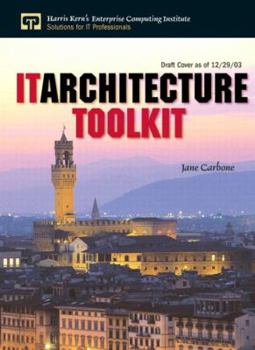It Architecture Toolkit
Select Format
Select Condition 
Book Overview
This 'toolkit' defines all the critical parts of sound IT architecture Learn the skills necessary to effectively create IT architecture within AND throughout the corporation Thorough coverage walking... This description may be from another edition of this product.
Format:Hardcover
Language:English
ISBN:0131473794
ISBN13:9780131473799
Release Date:January 2004
Publisher:Prentice Hall
Length:256 Pages
Weight:1.30 lbs.
Dimensions:0.8" x 7.1" x 9.5"
Customer Reviews
4 ratings
Carbone nails it!
Published by Thriftbooks.com User , 19 years ago
Carbone takes the role of the enterprise architect and lays out a step-by-step approach for success. She breaks down Zachman's theoretical framework into a practical how-to manual. Zachman taught you what data to collect; Carbone teaches you how to use that data. By using examples and exercises, Carbone guides you through the sometimes overwhelming process of identifying the business problems; then helps you develop key actionable items in order to solve these problems and meet business objectives. I strongly recommend this book as well as her training course that covers the same subject matter.
Great for the novice
Published by Thriftbooks.com User , 19 years ago
This is a great book with a ton of practical advice, examples and exercises. I think the test with any IT book is can you apply the information easily to what it is you do, and the answer here is certianly "yes". Thr infomation is presented in the context of an imaginary project, and leads the reader through each step in an easy to follow format. A well done book that is well worth a sunday afternoon.
Information Governance
Published by Thriftbooks.com User , 19 years ago
Jane Carbone provides a practical guide to implementing Enterprise Architecture. The book is drawn from Jane's extensive experience of developing enterprise and data architectures.It defines a best practice Enterprise Architecture approach using the Zachman Framework. The book is organised to describe:1. A business framework for collecting and analysing key enterprise business information. This entails defining current and target business states and, identifying gaps and opportunities.2. An IT framework for translating business opportunities into plans. This entails defining principles, models, listing key IT resources and standards.3. An implementation framework for delivering Enterprise Architecture projects. This entails identifying, selecting and prioritising projects.4. Key implementation activities including defining and establishing metrics, gaining buy-in from executives and IT staff and, detailing governance processes for enabling compliance.5. Key architecture processes, roles and human resource policies.6. Enterprise Architecture deliverables. This includes: the IT plan (updated at least annually); an annual financial plan for IT; a project architecture assessment; a quarterly update and presentations.This book is an asset to anyone who is grappling with the implementation of an Enterprise Architecture capability within a large organisation. It provides a holistic view of information governance centred around data. It is particularly relevant for people engaging in regulatory and compliance initiatives such as Sarbannes Oxley and Basel II.Lastly, Jane has written a handbook for practitioners, it is written in a clear and concise manner. It exudes the experience of someone who has learnt Enterprise Architecture the hard way!
Pragmatic addition to body of knowledge
Published by Thriftbooks.com User , 19 years ago
I've used a number of approaches to architecture, including the Zachman Framework, the RUP 4+1, SEI's ATAM, and a plethora of others. I was skeptical that this book was going to add anything of value to the art and practice of architecture. I was wrong. This book gives a realistic approach to architecture. Better, with minor tailoring it can be applied to any of the more mainstream methodologies, and does so because it is a toolkit of methods more than a formal methodology. Of course, if you are not using one of the plethora of architecture methodologies, this book's approach will also serve nicely as a standalone methodology as well.The approach is based on "Infomajic Enterprise Architecture Toolkit", which was developed by the author's company (Infomajic). In some ways the approach is a scaled down version of the Zachman Framework - indeed, there is a fairly detailed comparison between the two starting on page 11. There are three main stages to the architecture toolkit, (1) connecting the architecture to business, (2) developing the architecture itself, and (3) implementation strategies. The latter is what sets this book apart from many which focus on 'fun' stuff and gloss over the gory details associated with implementation. Each step within these three stages are thoroughly discussed in great detail, yet the author's brisk writing style makes even the most mundane aspects highly readable.Key aspects of this book that I particularly like include copious real world examples, width and depth of the content, and outstanding use of charts and tables to convey information. In addition to the detailed approach in the body of the book, the nine appendices are invaluable aids, ranging from interview outlines, to estimating work effort guidelines, to sample job descriptions and architecture assessment workshop outlines.Regardless of which architecture methodology you are using (or are committed to using), you'll gain many useful ideas from this book. If you are searching for a viable methodology, this one is complete and has been proven in the real world.




